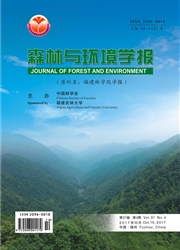

 中文摘要:
中文摘要:
对莘口教学林场不同林龄杉木人工林细根各级根序的平均直径、比根长、比表面积、组织密度及碳氮含量差异进行分析。结果表明:随着根序级别的递增,3个林龄杉木细根的平均直径、组织密度和C含量及C/N均呈增加趋势,而比根长、比表面积和N含量均呈减小趋势;随着林龄的增加,杉木细根同一根序的比根长、比表面积与C含量和C/N呈凹型变化趋势,而平均直径和组织密度则呈凸型变化趋势,N含量没有明显的变化特征。可见,杉木细根不同根序间的形态和碳氮含量存在异质性,用根序分级方法可区分这种异质性,这可为今后杉木根系养分利用研究中细根的分级提供科学依据。
 英文摘要:
英文摘要:
Fine root samples in Xinkou Experimental Forestry Farm were collected from different Chinese fir plantations of different stand ages and were grouped into different orders. Average diameter, specific root length, specific surface area, tissue density, con- centrations of C and N content, and fine root density were measured. The results showed as follows. With increasing in root orders, the average diameter, tissue density and C content and C/N of the fine roots increased ; but the root length, specific surface area and N content decreased. With increasing in forest ages, root length, specific surface area, C content and C/N as a whole were shown as the trend of ' concave ' ; average diameter and tissue density overall were shown as the trend of ' convex' ; but the N content had no obvious regularity. Those results demonstrated that there was heterogeneity in morphology and C and N content of the fine roots of Chinese fir among different root orders, which could be distinguished with root order grading method. That investigation has provided a scientific basis for the further research on the classification of fine roots about nutrient utilization in Chinese fir.
 同期刊论文项目
同期刊论文项目
 同项目期刊论文
同项目期刊论文
 期刊信息
期刊信息
